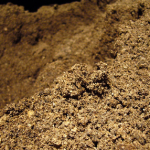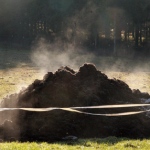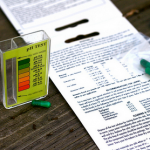Soil & Nutrients
Soil
 Fill an upside down tomato planter with a well-draining potting soil designed for vegetables. Look for a potting soil that includes compost or peat moss for nutrients. High quality potting soil is available at garden supply stores. Purchase potting soil rated for vegetable growth.
Fill an upside down tomato planter with a well-draining potting soil designed for vegetables. Look for a potting soil that includes compost or peat moss for nutrients. High quality potting soil is available at garden supply stores. Purchase potting soil rated for vegetable growth.
A common problem with upside down planters is that the soil tends to dry out quickly if left uncovered. To prevent this, add several herb or small flower plants to the top of an open upside-down container to prevent soil loss during heavy rains. Basil, parsley, marigolds and sweet alyssum all work well for this purpose.
Fertilizer
 Tomatoes are vigorous, fast growing, and heavy feeding plants which require fertilization a few times during the season. Tomatoes have specific nutritional needs such as nitrogen, phosphate, potash, calcium, magnesium, potassium and other micro-nutrients to build cell wall structure and increase plant vigor.
Tomatoes are vigorous, fast growing, and heavy feeding plants which require fertilization a few times during the season. Tomatoes have specific nutritional needs such as nitrogen, phosphate, potash, calcium, magnesium, potassium and other micro-nutrients to build cell wall structure and increase plant vigor.
Adding a slow-releasing tomato fertilizer to the potting soil will provide nutrients to the plants during the growing season. A balanced or 5-6-5 tomato fertilizer works well. Mix the fertilizer into the soil before adding soil to the planter. Follow the package instructions based on the amount of soil needed for the planter.
pH Balance
 Testing soil Ph will ensure that you are getting the healthiest and biggest yield of crops from your garden. Testing soil pH periodically will maintain an environment for plants to continue to produce optimally. Everything (soil, food, even a person) has a pH level. pH is a measurement of how acidic an entity is. Conducting a soil pH test is the best way to find out how acidic your soil is.
Testing soil Ph will ensure that you are getting the healthiest and biggest yield of crops from your garden. Testing soil pH periodically will maintain an environment for plants to continue to produce optimally. Everything (soil, food, even a person) has a pH level. pH is a measurement of how acidic an entity is. Conducting a soil pH test is the best way to find out how acidic your soil is.
Different types of plants have different requirements for their optimal pH level. For example, tomato plants prefer a soil pH level that’s between 5.5 and 7.5. Lettuce prefers a pH between 6.0 and 7.0, but won’t tolerate a pH over 7.0. Placing plants in soil that does not match their pH needs can weaken the plants by: i) making them more susceptible to plant diseases and insect infestations ii) cause the plant to grow more slowly and have a smaller yield and, iii) reduce the amount of nutrients being passed from the soil to the fruit, herbs or vegetables. Most plants to grow well, prefer a pH level of 6.5 to 7.5. To learn more about plant pH levels and how to test pH levels go to www.howtogardenadvice.com/soil_prep/ph_soil_testing.html

This Post Has 0 Comments